Honoring the Spirit of All Cowlitz People 15th Annual Pow Wow
September 20, 2014 Grand Entry 1pm, 7pm; Salmon Dinner 5pm
1242 State Route 505, Toledo Washington 98591
syəcəb
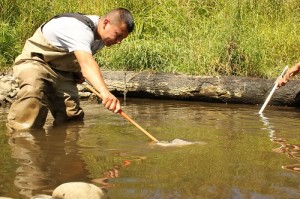
Source: Northwest Indian Fisheries Commission
This summer, the Nisqually Tribe, the Nisqually Land Trust and the South Puget Sound Salmon Enhancement Group are tacking on another 1.5 miles of restored habitat to Ohop Creek.
“In this stretch of creek, salmon aren’t really given much space to feed or hide,” said David Troutt, natural resources director for the tribe. “We’ll be restoring the creek back to a natural shape and giving the salmon the habitat they need to survive.”
Over a century ago farmers turned the creek into a straight-flowing ditch in an attempt to dry out the valley floor and create cattle pasture. However, deep clay deposits in the soil continued to hold water year round, and despite the failed effort to completely dry the valley the stream remained channelized.
“It went from a shallow, meandering stream that was very good for salmon to a straight ditch,” Troutt said.
The Ohop Creek restoration will include digging an entirely new channel as well as adding other features, such as logjams and deep pools, that will provide habitat for salmon.
Salmon habitat restoration on the creek began in 2009 with a repaired one-mile channel just upstream of the new site. That channel was constructed to restore a sinuous stream that connected to its floodplain. The floodplain, now replanted with native vegetation, re-creates 80 acres of healthy riparian habitat that controls water temperatures and stabilizes the stream banks.
The project partners have already documented the progress of the upstream restoration. “We’ve seen a lot of changes, down to the types of birds that visit the site,” Troutt said. Early results include increased use by salmon and the return of wildlife species, such as elk, that had not been seen in the valley for decades.
Ohop Creek is one of two major tributaries to the Nisqually River that can support chinook salmon and steelhead, both of which are listed as threatened under the federal Endangered Species Act. “Because there are only a few places other than the mainstem of the Nisqually River where they can spawn, increasing the quality of habitat in those places is important,” Troutt said. Ohop Creek also supports coho and pink salmon and cutthroat trout.
“Throughout Puget Sound, we’re seeing available salmon habitat continue to disappear, despite millions of dollars spent to restore and protect it,” Troutt said. “There is no larger threat to treaty rights than lost salmon habitat. Projects like this are a small step to reversing that trend.”
By Brandi N. Montreuil, Tulalip News
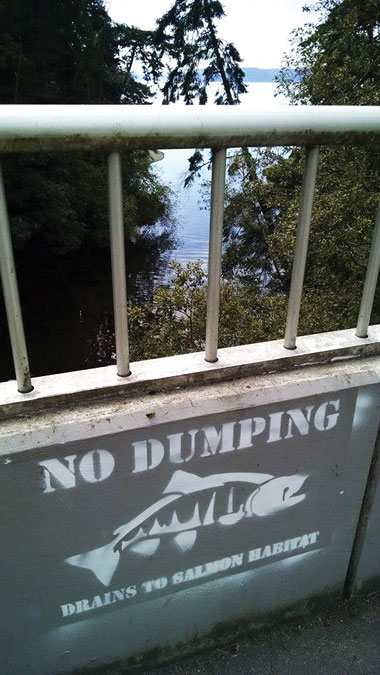
TULALIP – Through the summer break, 175 storm drains on the Tulalip Indian Reservation received a mini makeover due to a collaborative effort between Tulalip Tribes Natural Resources department and the Goodwill Aerospace Program.
Receiving help from 20 students from the Marysville/Everett area who participated in the Goodwill Aerospace program, the drains, located near the Tulalip Resort Casino, Totem Beach Road and Totem Beach Loop Road, now display a stenciled salmon graphic and custom message reading, “No Dumping; Drains to Salmon Habitat.” Tulalip Natural Resources hopes the message will remind the public of the risks salmon habitat face.
“Many people have the misperception that a drain in a street or parking lot is sent to a wastewater treatment plant, but it is not,” explains Valerie Streeter, Tulalip Natural and Cultural Resources stormwater planner. “ After a rain storm, stormwater runoff enters the drain and is usually piped directly to a ditch, stream or bay with very little treatment. This water picks up heavy metals, copper from brake pads, Zinc from tires, and oils from engines, and delivers these pollutants to our waterways. Salmon are especially sensitive to copper, which alters their response to predators and damages their olfactory organs, how they smell. Zinc and oils also damage aquatic plants and animals.”
Students involved in the program were required to participate in service learning projects, which involves learning about the science and background of a project and then volunteer their time toward that project.
“Protecting our watersheds and salmon habitat are very important and we want the community to understand that dumping anything down storm drains can impair fish and other aquatic creatures because storm drains drain directly to streams, lakes, and even the bay,” said Kelly Finley, Tulalip Tribes Natural Resources Outreach and Education Coordinator.
Streeter explains that when people wash their cars or driveway and either dump or allow the dirty wash water into the storm drains, this contributes to water pollution. “It is better to wash your car on the lawn or use a car wash, which are connected to wastewater treatment plants. Pet waste is another common pollutant in our water, which can pass diseases on to other animals or even us humans.”
“The worst is an old practice of dumping used oil from an oil change into the storm drains,” said Streeter, who recommends discarding used oil at appropriate places, such as the automotive center at the Walmart Supercenter located in Quil Ceda Village, who will discard the oil free of charge.
For more information on how you can help in salmon recovery, please visit Washington State Recreation and Conservation Office’s website at www.rco.wa.gov/salmon_recovery/what_you_can_do.shtml.
Brandi N. Montreuil: 360-913-5402; bmontreuil@tulalipnews.com
By Quinn Russell Brown, The Everett Herald

Wanda Sykes will kick off a 15-show fall tour at Tulalip Resort Casino this weekend.
The veteran stand-up comedian will play Friday and Saturday night sets in the Orca Ballroom, where she most recently performed in May 2013.
“I’ve been there several times, and I keep going back,” Sykes told The Herald. “It’s a loud room. It’s not a theater setup — it’s kind of like a banquet room. We get people close together.”
Sykes, 50, is using the tour to workshop material for her next comedy special.
“A big hunk of it I already have worked out, now it’s putting the polish on,” she said. “It’s polish, that’s what it is.”
While she’s never shied away from political humor in the past, Sykes claims she’s been less interested in current events since she and wife Alex Sykes had twins in 2008.
“Once you become a parent, you just don’t have time,” she said. “And when you do have time to watch TV or read, you just want something dumb. You want to let your mind take a break. I watch the news, I’m looking at stuff in Iraq and ISIS. It literally hurts my brain.”
Lately she sticks to detective and crime shows when it comes to TV.
“At least that stuff gets solved,” she said. “They have answers for it.”
She took this summer off to spend time with her family, but she admits she was still working.
“You never shut the brain off as far as thinking of funny stuff,” she said. “That’s where I draw the comedy from — from real life.”
That doesn’t mean she was cracking her family up. When asked if her kids think she’s funny: “They find me entertaining, I’ll put it that way.”
Like many stand-up comics who have moved into TV and film, Sykes still considers herself a comedian above all else. It’s what she did for a decade before hitting the screen in “The Chris Rock Show.”
“I got the opportunity to write for Chris, it was like, ‘Oh yeah, definitely,’” she said. “Then they put me in front of the camera, and that took it to another level.”
She won an Emmy with the writing team on “The Chris Rock Show.” Since then she’s acted in Hollywood comedies, voiced characters in animated movies like “Rio” and “Ice Age: Continental Drift” and had recurring roles in “Curb Your Enthusiasm” and “The New Adventures of Old Christine.” She now plays Senator Rosalyn DuPeche on the Amazon original series “Alpha House.”
In 2012, Sykes dove into the business side of things by co-founding Push It Productions. The move allowed her to become an executive producer of NBC’s “Last Comic Standing” as well as launch a show about women in comedy on the Oprah Winfrey Network.
“Developing and producing and doing things behind the camera, putting other talent out there, that was one thing that I wanted to do,” she said. “We’re doing that now.”
Still, she says she loves being in front of the camera and wants to eventually be the lead in a big movie.
“If I could just get one of those superhero movies, man! That would be awesome,” she said.
Some entertainment writers have suggested that Sykes be considered for “Ghostbusters 3” — rumored to be an all-female reboot of the sci-fi comedies of the 1980s — but she wasn’t familiar with the prospect.
“Oh, really? Awe, boy. I haven’t seen that,” she said. “I would love that!”
Doors at 7 p.m. and show at 8 p.m. both nights. 21+. 10200 Quil Ceda Blvd, Marysville.
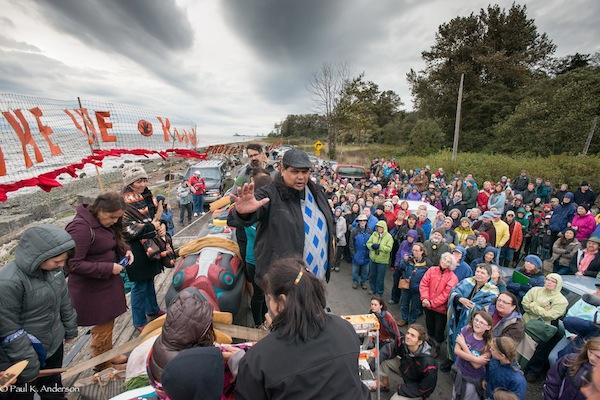
LUMMI NATION, Washington—At each stop on the totem pole’s journey, people have gathered to pray, sing and take a stand.
They took a stand in Couer d’Alene, Bozeman, Spearfish, Wagner and Lower Brule. They took a stand in Billings, Spokane, Yakama Nation, Olympia and Seattle. They took a stand in Anacortes, on San Juan Island, and in Victoria, Vancouver and Tsleil Waututh.
They’ll take a stand in Kamloops, Calgary and Edmonton. And they’ll take a stand at Beaver Lake Cree First Nation, where the pole will be raised after its 5,100-mile journey to raise awareness of environmental threats posed by coal and oil extraction and rail transport.
“The coal trains, the tar sands, the destruction of Mother Earth—this totem [pole] is on a journey. It’s calling attention to these issues,” Linda Soriano, Lummi, told videographer Freddy Lane, Lummi, who is documenting the journey. “Generations yet unborn are being affected by the contaminants in our water.… We need people to take a stand. Warrior up—take a stand, speak up, get involved in these issues. We will not be silent.”
The 19-foot pole was crafted by Lummi master carver Jewell James and the House of Tears Carvers. The pole and entourage left the Lummi Nation on August 17 for 21 Native and non-Native communities in four Northwest states and British Columbia. The itinerary includes Olympia, the capital of Washington State, and Victoria, the capital of British Columbia. The pole is scheduled to arrive at Beaver Lake Cree on September 6.
The journey takes place as U.S. energy company Kinder Morgan plans to ship 400 tanker loads of heavy crude oil each year out of the Northwest; a refinery is proposed in Kitimat, British Columbia, where heavy crude oil from Enbridge’s Northern Gateway pipeline would be loaded onto tankers bound for Asia; and as Gateway Pacific proposes a coal train terminal at Cherry Point in Lummi Nation territory. Cherry Point is a sacred and environmentally sensitive area; early site preparation for the terminal was done without permits, and ancestral burials were desecrated.
In a guest column published on August 11 in the Bellingham Herald, James wrote that Native peoples have long seen and experienced environmental degradation and destruction of healthy ecosystems, with the result being the loss of traditional foods and medicines, at the expense of people’s health.
And now, the coal terminal proposed at Cherry Point poses “a tremendous ecological, cultural and socio-economic threat” to Pacific Northwest indigenous peoples, James wrote.
“We wonder how Salish Sea fisheries, already impacted by decades of pollution and global warming, will respond to the toxic runoff from the water used for coal piles stored on site,” he wrote. “What will happen to the region’s air quality as coal trains bring dust and increase diesel pollution? And of course, any coal burned overseas will come home to our state as mercury pollution in our fish, adding to the perils of climate change.”
James wrote that the totem pole “brings to mind our shared responsibility for the lands, the waters and the peoples who face environmental and cultural devastation from fossil fuel megaprojects.… Our commitment to place, to each other, unites us as one people, one voice to call out to others who understand that our shared responsibility is to leave a better, more bountiful world for those who follow.”
‘This Is the Risk That Is Being Taken’
Recent events contributed to the urgency of the totem pole journey’s message.
Two weeks before the journey got under way, a dike broke at a Quesnel, British Columbia, pond that held toxic byproducts left over from mining; an estimated 10 million cubic meters of wastewater and 4.5 million cubic meters of fine sand flowed into lakes and creeks upstream from the Fraser River, a total of four billion gallons of mining waste. A Sto:lo First Nation fisheries adviser told the Chilliwack Progress of reports of fish dying near the spill, either from toxins or asphyxiation from silt clogging their gills; and First Nation and non-Native fisheries are bracing for an impact on this year’s runs.
RELATED: Video: Watch 4 Billion Gallons of Mining Waste Pour Into Pristine B.C. Waterways
On July 24, a Burlington Northern train pulling 100 loads of Bakken crude oil derailed in Seattle’s Interbay neighborhood. The railcars didn’t leak, but the derailment prompted a statement from Fawn Sharp, president of the Quinault Indian Nation and the Affiliated Tribes of Northwest Indians and Area Vice President of the National Congress of American Indians.
“People need to know that every time an oil train travels by, this is the risk that is being taken,” she said. “These accidents have occurred before. They will occur again. … The rail and bridge infrastructure in this country is far too inadequate to service the vast expansion of oil traffic we are witnessing.”
RELATED: Seattle Oil-Train Derailment Hits Close to Home for Quinault
A year earlier, on July 6, 2013, an unmanned train with 72 tank cars full of Bakken crude oil derailed in a small Quebec village, killing 47 people. An estimated 1.5 million gallons of oil spilled from ruptured tank cars and burned; according to the Washington Post, it was one of 10 significant derailments since 2008 in the United States and Canada in which oil spilled from ruptured cars.
RELATED: Lac-Mégantic Rail Tragedy Resonates in Quinault Nation as Victims Are Memorialized
Feds Call Bakken Crude Volatile as Quinault Warn Against Oil Rail Transport
Some good news during the journey: As the totem pole and entourage arrived at the Yankton Sioux Reservation in Wagner, South Dakota, word was received that the Oregon Department of State Lands rejected Ambre Energy’s application to build a coal terminal on the Columbia River; the company wants to ship 8.8 million tons of coal annually to Asia through the terminal.
RELATED: Treaty Victory as Northwest Tribes Celebrate Oregon Coal Train Rejection
One of the concerns that communities have about coal transport is exposure to coal dust; those concerns are shared by residents of Plaquemines Parish, Louisiana, where proponents of a coal terminal on the Mississippi River forecast an increase in Gulf Coast coal exports from seven million tons in 2011 to 96 million by 2030.
Dr. Marianne Maumus of Ochsner Health Systems told the New Orleans Times-Picayune that coal dust contains heavy metals including arsenic, cadmium and mercury, and can cause cancer, neurological, renal and brain-development problems.
“I think the risk is real. I think there is a lot of potential harm from multiple sources,” Maumus told the Times-Picayune.
James said there are alternatives to coal and oil—among them energy generated by wind, sun and tides.
“But we’re not going to move toward those until we move away from fossil fuels,” he said.
In his Nation’s territory, Yakama Chairman JoDe L. Goudy told videographer Lane he hopes the pole’s journey will help the voice of Native people “and the voice of those people across the land that have a concern for the well-being of all” to be heard.
“May the journey, the blessing, the collective prayers that’s [being offered] and the awareness that’s being created lift us all up,” he said, “lift us all up to find a way to come against the powers that be … whether it be coal, whether it be oil or whatever it may be.”
Albert Redstar, Nez Perce, advised young people: “Remember the teachings of your people. Remember that there’s another way to look at the world rather than the corporate [way]. It’s time to say no to all that. It’s time to accept the old values and take them as your truths as well.… They’re ready for you to awaken into your own heart today.”
To Unite and Protect
The totem pole journey is being made in honor of the life of environmental leader and treaty rights activist Billy Frank Jr., Nisqually. Frank, chairman of the Northwest Indian Fisheries Commission, walked on in May.
RELATED: The Fire That Was Billy Frank Jr.; Indian Country’s Greatest Defender
James said the pole depicts a woman representing Mother Earth, lifting a child up; four warriors, representing protectors of the environment; and a snake, representing the power of the Earth. The pole journey has been undertaken in times of crisis several times this century.
In 2002, 2003 and 2004, to help promote healing after the 9/11 terrorist attacks, James and the House of Tears Carvers journeyed across the United States with healing poles for Arrow Park, New York, 52 miles north of Ground Zero; Shanksville, Pennsylvania, where the hijacked United Airlines Flight 93 crashed; and Washington, D.C.’s Congressional Cemetery, seven miles from the Pentagon. And In 2011, James and a 20-foot healing pole for the National Library of Medicine visited nine Native American reservations en route to Bethesda, Maryland. At each stop on the three-week cross-country journey, people prayed, James said at the time, “for the protection of our children, our communities and our elders, and generally helping us move along with the idea that we all need to unite and protect the knowledge that we have, and respect each other.”
Read more at http://indiancountrytodaymedianetwork.com/2014/09/02/lummi-totem-pole-journey-rallies-voices-against-environmental-destruction-156696?page=0%2C2
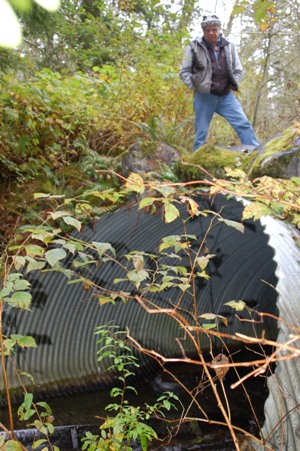
Source: Northwest Indian Fisheries Commission
The Olympian wrote an editorial urging the state to heed a federal injunction to fix fish-blocking culverts:
Imagine you are driving on the freeway, returning from a long trip, longing with all your heart just to be home. Suddenly you are forced to a complete stop because the freeway is broken and you are facing a 10-foot cliff. There’s no way forward, and as cars pile up behind you, no way back.
That’s pretty close to what a salmon experiences when, returning to its native stream from its long journey out to sea, it confronts an impassable culvert under a highway. Every cell in its body is consumed by the desire to go upstream; that is the life goal of every salmon. If it can’t go upstream to spawn, it can’t perpetuate its species.
According to the Washington Department of Transportation, there are 1,987 barriers to fish passage in the state highway system. As of 2013, 285 fish passage projects have unblocked 971 miles of potential upstream fish habitat. But a U. S. District Court injunction has mandated that 1,014 more be corrected by 2030.
Failing to correct culverts that block fish passage violates the treaty rights of tribes whose way of life depends on healthy salmon runs. Treaties are, by definition, the supreme law of the land. We like to think that the days of breaking treaties with Indian tribes are in the past, but the sad fact is we’re stilling doing it – and the result is the same as it has always been: broken treaties threaten the survival of tribal culture and livelihood, as well as the extinction of wild salmon.
Culvert repair is part of the state’s transportation budget – or would be, if the legislature could muster the political will to actually pass a transportation budget, which it has repeatedly failed to do. And even if and when a transportation budget is passed, there will be intense pressure to put the transportation needs of people ahead of the needs of fish and treaty rights.
The Washington Department of Transportation estimates the cost of complying with the federal court injunction – which applies only to tribes in Western Washington – at $2.4 billion, or $310 million per biennium. In the current biennium, they will spend $36 million. At this rate, it will take centuries, not decades, to complete this work.
Secretary of WSDOT Lynn Peterson wryly describes the federal court injunction as “Transportation’s McCleary decision,” a reference to the state Supreme Court order for the Legislature to fully fund public education, even if it means taking truly drastic action, such as closing down other state agencies. When a federal court orders the state to do something – in this case, obey treaties – the state surely ought to heed the injunction.
We understand the Legislature’s dilemma. Voters hate taxes. Legislators like to get re-elected. But when both state and federal courts rule that we’re not meeting our obligations to the next generation of children or of salmon, it ought to be a wake up call.
Both legislators and voters must recognize that it’s time to move beyond our own self-interest, and to do what’s right for our children, the tribes, and the salmon.
Gathering to Protect the Sacredness of the Salish Sea, the Nawtsamaat Alliance’s “Symbol of Unity” for the blessing and launch at Daybreak Star.
September 7, 2014 at the Daybreak Star Indian Cultural Center, Seattle, WA
RSVP Here: http://www.brownpapertickets.com/event/832983
What does this Symbol of Unity Represent?
The North Star is symbolic of awakening, light, and wisdom. It is the guiding light – especially in dark times- and represents our unified direction for goodness. The 7 rays of the star represent the 7 generations we fight to protect.
The Orca whales represent the coming together of many peoples. Orcas are the guardians of the waters, the protectors, and guardians of travelers. They are a symbol of unity and of goodness.
“Our goodness is our strength.”-Sundance Chief Rueben George
(This image of the North Star was inspired by a carving by Master Carver Tom Paul who gave us his blessing and permission to use it. Tom is from the Coast Salish Nuu-Cha-Nulth Nation. The orca whales were inspired when Sundance Chief Rueben George said that the Sacred Bundle Holder to be used at the International Treaty Signing had an image of a star similar to this one surrounded by two Orcas coming together in unity. Tim Paul, Tom’s father, knew Rueben’s Grandfather Dan George. Artist Heather Elder volunteered her time and beautiful talent to bring this Poster and Symbol together for us.)
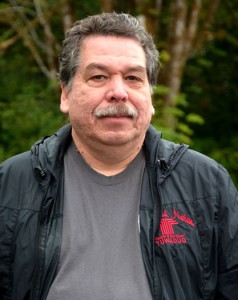
Note: Being Frank is the monthly opinion column that was written for many years by the late Billy Frank Jr., NWIFC Chairman. To honor him, the treaty Indian tribes in western Washington will continue to share their perspectives on natural resources management through this column. This month’s writer is Dave Herrera, a Skokomish tribal member who serves as the tribe’s fish and wildlife policy advisor, and who also is an NWIFC commissioner.
By Dave Herrera, Skokomish Fish and Wildlife Policy Advisor
The late NWIFC chairman Billy Frank Jr. left us all many lessons during his time on this earth. One of the most important was also one of the simplest: “Tell the truth.”
But that’s not what the state of Washington is doing when it comes to salmon recovery. You wouldn’t know it from what state government tells us, but the truth is that salmon recovery is failing.
At the center of that truth is the fact that we are losing salmon habitat faster than it can be restored. We cannot recover wild salmon until we stop the bleeding in our watersheds and estuaries.
Another truth is that tribal treaty rights are one of the few things strong enough to stand between all of us and the extinction of wild salmon. We have demonstrated that time and again over the decades.
Most recently, we showed that truth with a victory in the culvert case. We the filed suit in 2001 to force the state to repair hundreds of failing, fish-blocking culverts. These blockages under state roads cut off salmon from hundreds of miles of spawning and rearing habitat. The case was filed as a sub proceeding of the 1974 Boldt decision in U.S. v. Washington that upheld our treaty fishing rights reserved in treaties with the United States.
On March 29, 2013, federal district court Judge Ricardo Martinez confirmed those rights by issuing a permanent injunction. He ordered the state to repair more than 600 of its fish-blocking culverts over the next 17 years. He wanted to “ensure that the State will act expeditiously in correcting the barrier culverts which violate treaty promises.” Martinez noted that funding for the repairs would come from the state’s separate transportation budget, not at the cost of education or other social services.
Judge Martinez clearly ruled that our treaty-reserved right to harvest salmon also includes the right to have those salmon protected so that they are available for harvest. And not only by tribes, but by everyone who lives and fishes in the region.
It’s the same with tribal hatcheries and the 40 million or so salmon they produce every year. Tribal hatchery production makes the pie bigger for all because everyone can harvest those fish.
Without the tribes, the salmon and its habitat would be in far worse shape than it is today. We bring to the table our treaty rights, traditional and scientific knowledge, funding, and a strong cultural commitment to recovering the salmon resource. Everyone benefits from the work we do.
Perhaps most importantly, tribes and our treaty rights bring the rule of federal law to natural resources management. Federal law trumps state law and treaties are protected under the U.S. Constitution as the “supreme law of the land.”
The truth is that tribes aren’t the only beneficiaries of treaty rights. Non-Indians benefit from them as well. Besides sharing the natural resources of the region with the tribes, non-Indians have homes, businesses and schools on lands ceded by the tribes in return for the fishing, hunting and gathering rights tribes reserved in the treaties.
But our treaty rights – and the protection they give to all – are under constant, heavy attack by those who want to close our fisheries, shut down our hatcheries and destroy the salmon’s home. That puts treaty rights at risk for everyone.
We’re all in the same canoe, so let’s tell the truth: salmon recovery is failing. Tribal treaty rights are one of the few things that might keep salmon from disappearing altogether. The tribes will not allow salmon recovery to fail. That is why we must pull together to protect our natural resources and the treaty rights that protect those resources and all of us.
Source: Catalytic Community
On September 2nd, the Seattle City Council will vote on a resolution supported by members of the Seattle Urban and Reservation Native communities to end Columbus Day in Seattle and replace it with Indigenous Peoples Day.
Come voice your support at the City Council meeting to this historic vote to abolish Columbus Day in Seattle and give rise to Indigenous Peoples Day.
At Noon we will meet in front of Seattle City Hall for drumming, singing and guest speakers. The Seattle City Council meeting begins at 2 PM. Bring your drums.
Columbus brought genocide and slavery to our lands, let us stand strong for our ancestors for what they endured and let us send a message to our youth and next generations that we will not tolerate celebrations in the honor of a man who committed mass atrocities.
The resolution is co-sponsored by Council-members Kshama Sawat and Bruce Harrell.